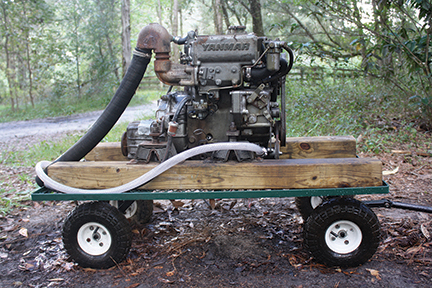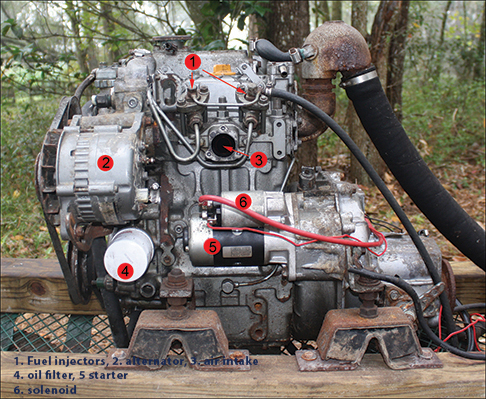How to become a more confident, anxiety free diesel mechanic (published March 2013)
I had departed the marina in Charleston, South Carolina bound for Florida, it was my first cruise on my cutter and there was no wind. But, as the two-cylinder diesel pushed my boat across the harbor towards the Intracoastal Waterway, I had a nagging anxiety—what would I do if the diesel engine quit?
At home I had four tractors, three older gasoline-powered machines and one, newer diesel-driven machine. The gasoline tractors were reliable and I used them the most because I knew I could fix them. They had carburetors, distributers, points and spark plugs, all things I understood. Diesel engines, on the other hand, don’t have those things, which make them harder for me to comprehend.
With the addition of this small cutter to the fleet of things to be maintained and repaired, I realized that I needed to learn about diesels if I wanted to be an anxiety-free, self-sufficient cruiser. So, I started with a class, read books and found a discarded engine to explore. Here are some helpful tips to becoming a more informed and confident do-it-yourself diesel mechanic.
TAKE A CLASS
Mack Boring and Parts Co., the distributor for Yanmar diesel engines in the United States, offers well-known marine diesel-training courses for boat owners. You can start with their one-day basic course and then dive into the two-day hands-on course. The basic course is a good introduction to diesel theory while the hands-on class is perfect for those who learn by doing, as most of your class time is spent working on engines.
They have various engine models to get your hands on and every attempt is made to pair students with the engine model they own. Larry Berlin has organized and instructed the classes for many years and his enthusiasm and endless knowledge make the courses enjoyable and practical for any experience level. For more information visit www.mackboring.com.
Another popular series of diesel engine courses are conducted by The Annapolis School of Seamanship. The Annapolis School offers a two-day Level I and a two-day Level II class. Both courses provide a mix of lectures and hands-on study that take students from the basics of diesel engine operation to more advanced troubleshooting and repair. Held on weekends, the classes are taught by experienced instructors John Martino and Scott Segal and tend to fill up quickly. For class schedules and pricing, visit their website www.annapolisschoolofseamanship.com.
There are many other quality diesel engine courses available around the country. Some are taught at community colleges and others can be found through sailing associations, clubs or schools. Any diesel engine course would be a great start to building your knowledge and confidence in maintaining and repairing your marine diesel engine.
READ ALL ABOUT IT
For self-guided learning and ready reference, there are a handful of useful books on marine diesel engines that can teach you the basics or help to further your education after completing a diesel course. One that I find particularly beneficial due to its simplicity, clear explanations and easy-to-follow troubleshooting chart is Troubleshooting Marine Diesel Engines by Peter Compton. Nigel Calder, the well-known fixer of all things marine, has also written a good book, Marine Diesel Engines, that is used by the Annapolis School of Seamanship in their series of diesel courses.
Two books that are a must-have for any self-sufficient cruiser are the engine manufacturer’s parts catalogue and service manual—both are specific to the engine model you own. They contain detailed line drawings of engine parts, exploded assembly schematics and tips on servicing and troubleshooting your engine. The manuals also include part numbers that will simplify placing parts orders, and many of these manuals are now available as PDF files that you can read on your computer or tablet.
Another valuable and necessary reference book will be a repair manual by Seloc Publishing Company. Though typically associated with gasoline engine manuals, Seloc does carry some manuals for diesels. The Seloc manual goes through individual repairs in a simple, bolt-by-bolt sequence and has photographs of the engine in each repair step. Specific chapters detail your engine’s electrical system, fuel system, cooling system and transmission; the manuals also include chapters on maintenance and on undertaking a complete engine overhaul.

PRACTICE MAKES PERFECT
Another great way to learn and practice diesel engine repair, troubleshooting and maintenance is to find a practice engine. In the 1980s and 1990s, production boats with diesel engines were manufactured in large numbers. Due to advanced age, many of these engines are now being replaced, which means you may be able to find an old engine for the price of scrap metal.
When searching for a practice engine, keep your eye out for a two-cylinder engine that can be carried by hand, hauled in a pickup or trailer and kept on a bench or small wagon. Water can be easily supplied with a garden hose and a jerry jug can be used as a fuel tank. One major advantage of working with a practice engine is that you can do things without fear of making a mistake and ruining your boat’s engine. It is also easier to use, since you won’t be working in the confined space of your boat.
With a practice engine, you can take out and inspect the engine’s injectors, remove and re-install the fuel pump, fresh water and raw water pumps, adjust the valves and learn how the fuel injection pump is installed and how it works. And if you break off a bolt in the block—that’s good—you can figure out what tools are needed and how to extract it without being stuck in a faraway anchorage.
Taking a marine diesel class, having the necessary books in your cruising library and practicing repairs on an engine will give you the knowledge needed to understand how diesel engines work and need to be cared for. Gaining the confidence to maintain, troubleshoot and repair your diesel will also make the cruising lifestyle more enjoyable and anxiety free.
Richard Estes has a farm in North Florida where he grows hay and peanuts. In the winter, when he’s not tinkering with engines on the farm, he can be found sailing somewhere along the “Thorny Path” in his 27 foot Island Packet cutter, Island Maid.
Top 10 Tips for diesel engine maintenance
• Change fuel filters • Change engine oil and filter • Change transmission oil • Clean air filter • Clean raw water strainer • Change raw water pump impeller • Inspect and adjust belts • Inspect coolant and heat exchanger • Lubricate throttle and gear controls • Clean electrical connections
















